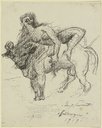Back to top
Lovis Corinth
Painter, Lithographer, Commercial artist (male), Etcher, Draughtsman and Writer (male)
- Born
- 1858 in Tapiau
- Died
- 1925 in Zandvoort
- School
- Impressionism
16 Works by Lovis Corinth
- “Carmencita”, Portrait of Charlotte Berend-Corinth in Spanish Dress
![“Carmencita”, Portrait of Charlotte Berend-Corinth
in Spanish Dress, Lovis Corinth]()
- Walchensee in Winter
![Walchensee in Winter, Lovis Corinth]()
- Anatomist with skelleton
![Anatomist with skelleton, Lovis Corinth]()
- Bull's head
![Bull's head, Lovis Corinth]()
- Europa on the bull
![Europa on the bull, Lovis Corinth]()
- Studien zu einem Selbstbildnis
![Studien zu einem Selbstbildnis, Lovis Corinth]()
- Self-Portrait
![Self-Portrait, Lovis Corinth]()
- New Building in Monte Carlo
![New Building in Monte Carlo, Lovis Corinth]()
- The Artist’s Father in his Sickbed
![The Artist’s Father in his Sickbed, Lovis Corinth]()
- Am Walchensee
![Am Walchensee, Lovis Corinth]()
- Berg See
![Berg See, Lovis Corinth]()
- Buchenwald
![Buchenwald, Lovis Corinth]()
- Die Totenklage
![Die Totenklage, Lovis Corinth]()
- Gebirgslandschaft mit See
![Gebirgslandschaft mit See, Lovis Corinth]()
- Mappe: Vorfrühling im Gebirge
![Mappe: Vorfrühling im Gebirge, Lovis Corinth]()
- Tal-Grund
![Tal-Grund, Lovis Corinth]()
Works displaying Lovis Corinth
Biography
Persons connected to Lovis Corinth
- Corinth, Franz Heinrich Father
- Berend-Corinth, Charlotte Wife
- Defregger, Franz von Teacher (male)
- Lategahn, Wilhelm Pupil (male)
- Löfftz, Ludwig von Teacher (male)
- Macke, August Pupil (male)
- Mataré, Ewald Pupil (male)
- Pfeiffer-Urspruch, Maria Pupil (female)
- Pinner, Erna Pupil (female)
- Franck, Philipp Friend (male)
- König, Leo von Friend (male)
- Liebermann, Max Friend (male)
- Leistikow, Walter Friend (male)
Groups and institutions Lovis Corinth belongs to
- Berlin Secession Artists' association
- Deutscher Künstlerbund (1903-1936) Artists' association
- Munich Secession Artists' association

















